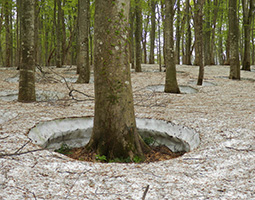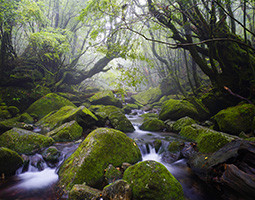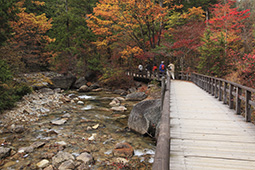INDEX
- English
- 日本語

“Agariko Daio,” a giant 300-year-old Agariko beech tree in the foothills of Mt. Chokai in Akita Prefecture - English
- 日本語

Nakashizuka (Asano) Tohru, President of the Forest Research and Management Organization

A Japanese beech forest in the snowy Hakkoda mountains 
A forest, stream and moss-covered rocks on the island of Yakushima 
A Japanese cedar forest in Noshiro City, Akita Prefecture 
Colorful autumn leaves in the Akasawa Natural Recreational Forest, Nagano Prefecture.
July 2021
Japan’s Diverse Forests

Since ancient times, Japanese people have lived their daily lives utilizing the blessings of forest resources. We interviewed Nakashizuka (alias Asano) Tohru, President of the Forest Research and Management Organization (FRMO), about the characteristics and functions of Japan’s forests.

According to the Government of Japan’s Forestry Agency, approximately two thirds of Japan’s land is covered in forest. What are the characteristics of Japan’s forests?
Because Japan is sufficiently warm and humid for forests to grow, the original vegetation of most places in Japan was forests. Moreover, because Japan’s land covers a wide range from north to south and has both lowland and alpine areas, the climate varies according to the region. So, there is a diversity of forest type, which can be roughly categorized as follows. There are evergreen forests that form in warm-temperate regions, mainly containing shii (Japanese chinquapin, Castanopsis sieboldii) and tabu (Japanese bay tree, Machilus thunbergii); deciduous forests that form in mountainous and cool-temperature regions, mainly containing beech (Fagus crenata) and oaks (Quercus spp.); and conifer forests that form in the mountainous areas of low-temperature regions, mainly containing fir (Abies spp.) and spruce (Picea spp.).
Forests similar to those found in Japan exist in Europe and eastern areas of North America too, but Japanese forests are richer in tree species. For example, in the case of deciduous forests, there are around twice as many tree species in Japanese forests as in European or North American forests. In Europe and North America, many trees became extinct during an ice age over 10,000 years ago, but in Japan there were few extinctions, presumably because glaciers and ice sheets did not develop at that time.

What kind of functions do forests have in Japan?
Forest ecosystems have a variety of functions. For example, they have the function of supplying resources such as timber and non-timber forestry products. Examples of non-timber forestry products include medicinal plants and edible wild plants and mushrooms, and these are abundant in Japanese forests. Forests also have a disaster risk reduction function. Because Japan is mountainous and rainy, landslides can easily occur. But trees develop deep root systems on mountain slopes, securing the earth, sand and rocks and preventing landslides. Woods along the coast act to weaken the power of a tsunami and prevent coastal sand being carried inland by wind. And forests also have a cultural function. For example, there are many sacred forests around temples or shrines, or forests with beautiful autumn colors which many tourists visit to enjoy.
During some periods in Japan, many trees were felled to build huge castles, temples and shrines, but more recently we have begun to regulate the areas for logging and to actively plant trees. In particular, Japanese cedar and hinoki cypress grow straight and are easy to process, so many were planted. In fact, around 40% of Japan’s forest area is planted forest and at present 70% of that area is Japanese cedar and hinoki cypress* forest.

You have researched Japanese beech forests for many years. What are some of the notable beech forests in Japan?
The beech forests in high snowfall areas by the Sea of Japan coast and in the Tohoku region are special. Mountainous regions there get over two to three meters of snow deposits in winter. Globally, it is extremely unusual to find beech forests in regions with such heavy snowfall. In spring one can see beautiful scenes that combine new green beech leaves and lingering snow. Shirakami-Sanchi was registered as a World Natural Heritage site because one of the world’s largest expanses of mostly untouched primeval beech forest remains in the high snowfall environment. In the case of the beech forest in the Hakkoda mountains, at the beginning of the twentieth century, horses and cattle were pastured in the forests, and they ate up the bamboo grass that obstructs beech regeneration. The forests were also cut for charcoal production after seedling growth became dense. Then, about 100 years later, beech forests of an almost even age became established in a very beautiful way.
Also, on the foothills of Mt. Chokai in Akita Prefecture, there is a forest where strange-shaped beech trees known as “Agariko” (pollard) grow. The trunks of normal beech trees extend straight upwards, but the trunks of Agariko are thick and uneven, and many thin trunks extend out from about two meters above the ground. And there is a reason for this. In that region, during winter locals cut down beech trees in the snow and used the wood for fuel and charcoal. Numerous new trunks would regenerate and grow from the stumps of the cut-down beech trees. Some of those newly-grown trunks would be left and some cut, and through this repeated cycle they became “Agariko” without withering or dying. One might say that the Agariko represent a sustainable relationship between humans and beech forests.

Before the spread of COVID-19 many people came from abroad to Japan to enjoy nature. Please tell us about the forests you’d like people from overseas to visit when the spread of COVID-19 is under control.
As well as the beech forests I mentioned previously, I recommend the forests of Yakushima, another World Heritage site. The forests are dim with thickly growing Japanese cedar and other trees and moss that covers the ground. They were the model for the forests that appear in the animated film Princess Mononoke. Also, in Noshiro City in Akita Prefecture, a region famous for Japanese cedar production, there is a forest that is tightly packed with big cedar trees aged on average around 250 years. It is wonderful to see straight-trunked and around 50-meter-tall cedars standing together. In the Kiso-gun district of Nagano Prefecture, which is famous for the production of hinoki cypress, there are various places where one can enjoy walks in hinoki forests, including the Akasawa Natural Recreational Forest, the birthplace of shinrin-yoku (forest bathing), the practice of healing mind and body by walking in the forest.

The world’s forests face various problems. How is Japan helping to solve those problems?
Forests have various functions; not just providing timber, but also functions such as CO2 absorption, disaster risk reduction and food production. By making use of the knowledge and techniques accumulated over many years, Japan helps in the conservation and improvement of those functions in developing countries. For example, the FRMO works with Japan’s Forestry Agency and the Japan International Cooperation Agency (JICA) to help Vietnam strengthen the disaster risk reduction function of its forests. It is also giving technological assistance related to management of forests and measurement of CO2 storage amounts in Peru and Brazil, with the aim of controlling climate change through the conservation of tropical rainforests.
By comprehensively analyzing the various functions of forests, the FRMO will continue to conduct research to quantify how and to what extent forests should be conserved, or whether, if they are used, sustainable and effective use is possible for that region, country, or the world. I believe that such efforts can also contribute to achieving the Sustainable Development Goals (SDGs).
* It is said that around four in ten of the Japanese population suffers from hay fever caused by cedar pollen. As a way to deal with this, the Forestry Agency has been implementing measures such as cutting down and using Japanese cedar plantations, replanting with saplings that produce little pollen, and realizing technology to reduce the amount of cedar pollen produced.

